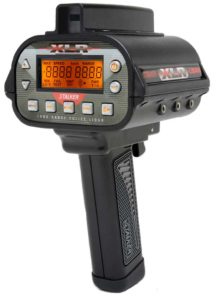Laser Speed Enforcement
Laser Radar Speed Enforcement
Police officers use various types of laser speed measuring devices to measure the speed of a motor vehicle.
A laser speed measuring device uses a laser beam to measure time vs. distance.
The instrument then makes a mathematical calculation to give a measurement of the speed of the vehicle, from this information the police officer writes a speeding ticket.
 Laser measures the time it takes a burst of infrared light to reach a car, bounce off and return back to the starting point, which would be the laser beam instrument the officer is holding.
Laser measures the time it takes a burst of infrared light to reach a car, bounce off and return back to the starting point, which would be the laser beam instrument the officer is holding.
By multiplying this time by the speed of light, the lidar system determines how far away the object is and gives a speed reading.
Unlike traditional police radar, lidar does not measure change in wave frequency or radio waves.
Instead, it sends out many infrared laser bursts in a short period of time to collect multiple distances to measure the speed of the moving vehicle.
The police officer looks through an eye piece (scope) on the instrument to view the vehicle.
The officers scope will be approximately two times field of view, like a two times set of binoculars. The police officer then targets the vehicle by placing a red dot on the vehicle within the scope.
Typically the police officer will put the red dot on the front of the car.
The officer then pulls a trigger on the unit, the laser unit sends out a beam of light and records approximately 13 speed readings within one second of activation by the officer.
Time vs Distance to Measure Speed
By multiplying time by the speed of light, the lidar system determines how far away the object is and gives a speed reading.
Unlike traditional police radar, lidar does not measure change in wave frequency or radio waves.
Instead, it sends out many infrared laser bursts in a short period of time to collect multiple distances to measure the speed of the moving vehicle. The police officer looks through an eyepiece (scope) on the instrument to view the vehicle.
Targeting the Vehicle
The officers scope will be approximately two times field of view, like a two times set of binoculars. The police officer then targets the vehicle by placing a red dot on the vehicle within the scope.
Typically the police officer will put the red dot on the front of the car.
The officer then pulls a trigger on the unit, the laser unit sends out a beam of light and records approximately 13 speed readings within one second of activation by the officer.
The speed laser compares the distance traveled by the time (Time x Distance) and gives a speed reading.
The officer can, by pushing a button on the laser instrument also receive a measurement of the distance in 1/10 of a meter that the instrument recorded the vehicle speeding at.
These speed guns will take approximately twelve readings in less than half a second, so they are extremely accurate.
With police radar, the car enters the beam and signals bounce back to the receiver.
The officer has to determine which vehicle was the vehicle that entered the radar beam was speeding. With laser, the police officer puts a dot from the scope on the car, the officer pulls a trigger and receives a reading instantly.
The police officer can pick a car out of a crowd or group, as long as he has a “line of sight” and can put the dot from the scope of the laser on the front of the vehicle.
With police radar the officer has to have line of sight to the vehicle, meaning in radar the lead vehicle or the first vehicle entering the beam is usually the speed recorded.
Therefore the laser gives the operator a much more accurate determination of the vehicles speed and gives pin point accuracy of which vehicle is involved.
The distance capabilities for a Laser unit are approximate up to one kilometre, normal operating range is approximate 200 to 500 meters
The accuracy is 99.9%

